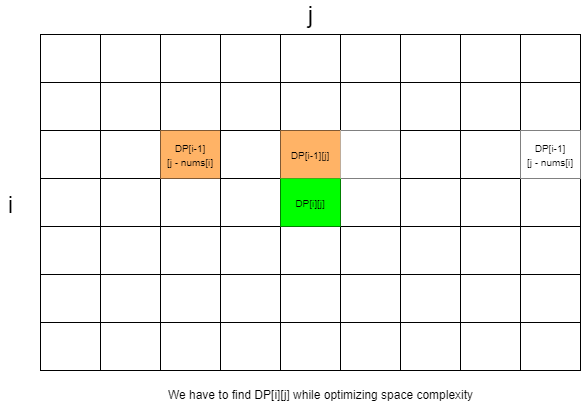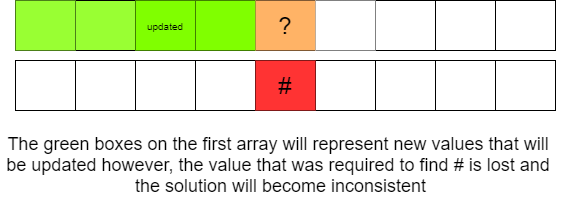When to Convert a 2-D DP Array To 1-D DP Array And How?

In which situation a 2 dimensional DP can be dropped to 1 dimension? Is there any principle or regular pattern?
Yes , the magic is the observation from the induction rule/recurrence relation!
Consider " Partition Equal Subset problem as an example", the induction rule:
-
If not picking
nums[i - 1], thendp[i][j] = dp[i-1][j] -
If picking
nums[i - 1], thendp[i][j] = dp[i - 1][j - nums[i - 1]]
You can see that if you point them out in the matrix, it will look something like this:

-
Optimize to
O(2*n): You can see thatdp[i][j]only depends on the previous row, so you can optimize the space by only using 2 rows instead of the matrix. Let's sayarray1andarray2. Every time you finish updatingarray2,array1has no value, you can copyarray2toarray1as the previous row of the next new row. -
Optimize to
O(n): you can also see that, the column indices ofdp[i - 1][j - nums[i]anddp[i - 1][j]are<= j. The conclusion you can get is: the elements of the previous row whose column index is> j(i.e.dp[i - 1][j + 1 : n - 1]) will not affect the update ofdp[i][j]since we will not touch them:

Thus if you merge
array1
and
array2
to a single array named
array
, and if you update
array
backward, all dependencies are not touched!

However, if you update forwards,
dp[j - nums[i - 1]]
is updated already, you cannot use it:

You may refer to the Dynamic Programming approach of Partition Equal Subset Sum Problem blog written here on Afteracademy.
Conclusion:
So the rule is that observe the positions of the current element and its dependencies in the matrix. Mostly if current elements depend on the elements in the previous row(most frequent case)/columns, you can optimize the space.
If you have any more approaches or you find an error/bug in the above solutions, please comment down below.
Happy Coding!
Enjoy Algorithms!





